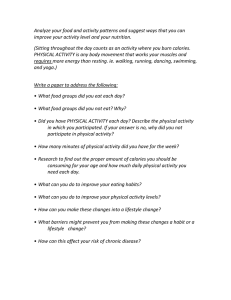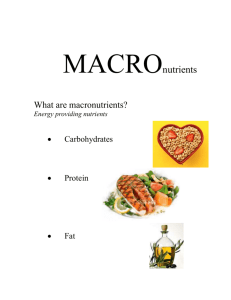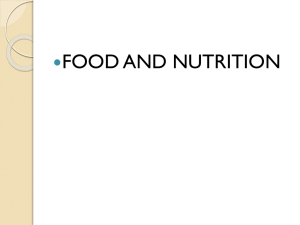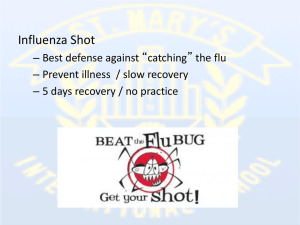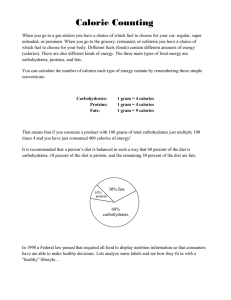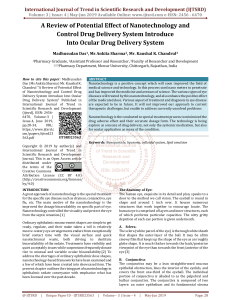Document
advertisement
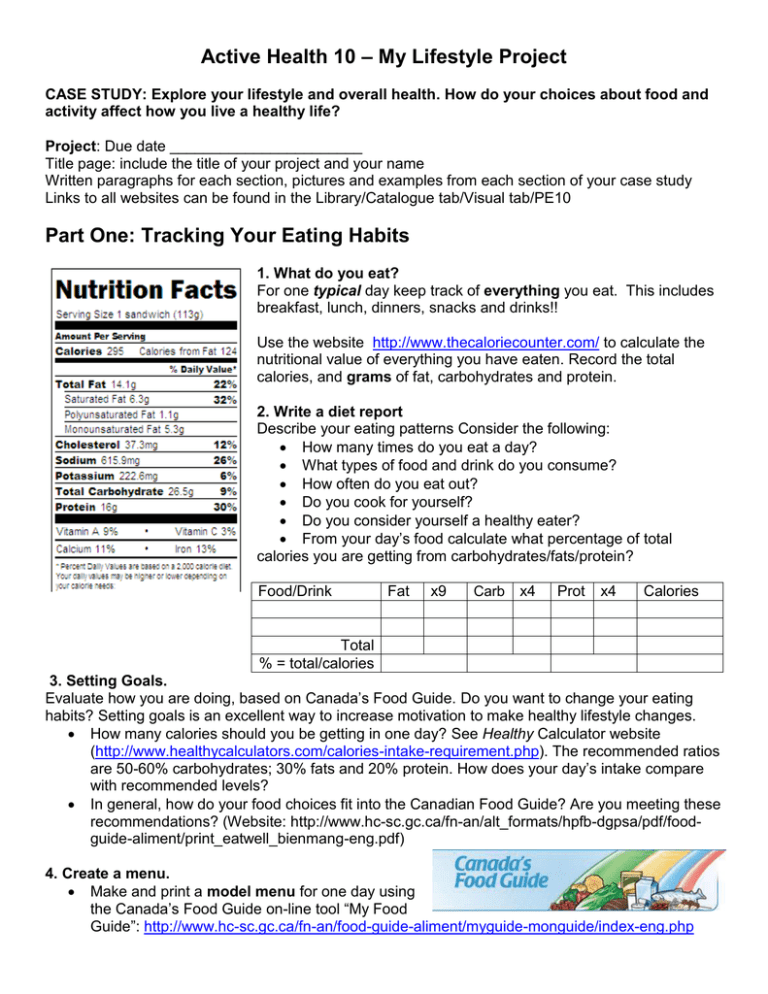
Active Health 10 – My Lifestyle Project CASE STUDY: Explore your lifestyle and overall health. How do your choices about food and activity affect how you live a healthy life? Project: Due date _______________________ Title page: include the title of your project and your name Written paragraphs for each section, pictures and examples from each section of your case study Links to all websites can be found in the Library/Catalogue tab/Visual tab/PE10 Part One: Tracking Your Eating Habits 1. What do you eat? For one typical day keep track of everything you eat. This includes breakfast, lunch, dinners, snacks and drinks!! Use the website http://www.thecaloriecounter.com/ to calculate the nutritional value of everything you have eaten. Record the total calories, and grams of fat, carbohydrates and protein. 2. Write a diet report Describe your eating patterns Consider the following: How many times do you eat a day? What types of food and drink do you consume? How often do you eat out? Do you cook for yourself? Do you consider yourself a healthy eater? From your day’s food calculate what percentage of total calories you are getting from carbohydrates/fats/protein? Food/Drink Fat x9 Carb x4 Prot x4 Calories Total % = total/calories 3. Setting Goals. Evaluate how you are doing, based on Canada’s Food Guide. Do you want to change your eating habits? Setting goals is an excellent way to increase motivation to make healthy lifestyle changes. How many calories should you be getting in one day? See Healthy Calculator website (http://www.healthycalculators.com/calories-intake-requirement.php). The recommended ratios are 50-60% carbohydrates; 30% fats and 20% protein. How does your day’s intake compare with recommended levels? In general, how do your food choices fit into the Canadian Food Guide? Are you meeting these recommendations? (Website: http://www.hc-sc.gc.ca/fn-an/alt_formats/hpfb-dgpsa/pdf/foodguide-aliment/print_eatwell_bienmang-eng.pdf) 4. Create a menu. Make and print a model menu for one day using the Canada’s Food Guide on-line tool “My Food Guide”: http://www.hc-sc.gc.ca/fn-an/food-guide-aliment/myguide-monguide/index-eng.php Part Two: Tracking your Activity Levels Record the activities you participate in for two average days, and the time you spent on each activity. Decide if the activity was active or sedate. Active Activity Sedate / Inactive Estimated Time Active or Sedate 1. 2. 3. 1. 2. 3. Total time spent being active: __________ (mins or hours?) Total time spent being sedate: __________ (mins or hours?) 1. Write a description of your activity patterns. Include your exertion levels (high/medium/low intensity), as well as the duration (length of time). In your write-up, also consider these questions: What do you do for fun and with your spare time – active and non-active activities? Why do you like to do these activities? How long have you been doing these activities? What changes might you consider making to have a healthier outcome? 2. Provide information about your recommended weight based on age, height and gender. Use the body mass index (BMI) charts provided in the What Health website (http://www.whathealth.com/bmi/chart-imperial.html) Examine and report how you compare/fit into the data. Remember that these charts do not take into account individual circumstances and differences (e.g. muscle mass is heavier than fat) 3. Make a Cardiovascular Exercise Plan Describe the benefits of physical activity for weight, energy balance and overall health. According to Canada’s Physical Activity Guide, teens between the ages of 14 – 18 should be active for 90 minutes per day!! How do you compare to these standards? What changes can be made to improve your activity levels? You may wish to look at the Nutristrategy website (http://www.nutristrategy.com/activitylist4.htm) chart indicating how many calories we burn doing various activities. Make a SMART plan to increase your physical activity this month by at least 30 minutes and to decrease non-active time. Remember, physical activity should include a combination of endurance, flexibility, and strength building activities. Specific: What do I want to do? I should describe exactly what I would like to achieve. Measurable: How much and how often will I do it? I will indicate a quantity, like number of times, duration and frequency, for the goal. Attainable: How will I do it? I should figure out ways in which my goal can be reached. My attitudes, abilities, skills and supports should be well-matched to the goal I am trying to achieve. Realistic: Can I do it? My goal should be something I am willing and able to commit to working towards. It should be challenging, but not so much so that I will not be able to achieve it. Timely: When will I do it? I will specify a time period (or time frame) during which I will work towards this goal. I will decide when I want to start working on it and by when I would like to have achieved it. Part Three: Recreation Activities (Choose option A or B) Option A: Research and provide some information about recreational activities that interest you or are available in your community. You might wish to refer to that Nutristrategy chart above. Option B: If you already participate in recreational activities, please record what they are and provide some specific information about them. You might wish to refer to that Nutristrategy chart above. Part Four: Stress Management Plan Explain how stress has consequences on health. What things can you do to reduce your stress levels? Part Five: What happens in Five Years? What predictions can you make for yourself in five years if you follow your plans and recommendations?
